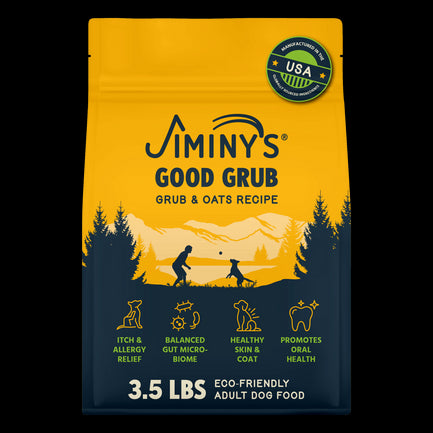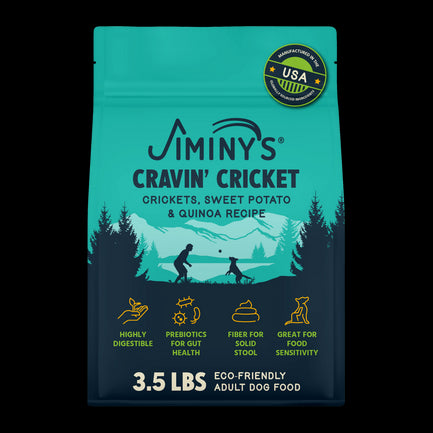TRAINING
A SUSTAINABLE TRAINING TREAT
When we set out to make a training treat, we reached out to our friend and advisor Ian Dunbar to talk about training and what is important in the design of a training treat.

Ian Dunbar, Jiminy’s advisor and animal behavior expert, pictured here meeting Timber for the first time. Ian was instrumental in specifying the design criteria for Jiminy’s Training Treats. As an animal behavior expert, he comes at it from a dog’s perspective!
For training, the criteria is very specific.
- Size & Shape – needs to be small so it can be eaten quickly without distracting your dog from the task at hand; also needs to be easy to hold and easy to break into really tiny pieces (especially important for extremely small dogs!)
- Low Calorie – learning something new takes many repetitions so keeping treat calories under control is vital – our training treats are under 3 calories per treat
- Convenient – the treats need to be easy to carry in your pocket or treat bag and not greasy (yuck) or crumbly
- Healthy – treats should be healthy and, better still, able to supplement your dog’s normal diet with added health benefits (example: omegas, vitamins, fiber, etc.)
- Delicious – a bit subjective, of course, but treats must excite your dog because otherwise they won’t work as a training tool
Not only do Jiminy’s training treats deliver on all of these criteria, but, because they’re from Jiminy’s, they’re also sustainable, humane and great for dogs with sensitivities to common ingredients such as chicken or beef! The best treat for your pup and your planet.
Subscribe to our newsletter to receive information about dog health, training tips, and exclusive subscriber offers. Plus, receive a code to save 15% on your first purchase.
REWARDS BASED TRAINING

This method of training teaches your dog that if he does what you ask then he gets a reward. Reward-based training is the best way to teach your dog new behavior because it’s effective, simple, and it enhances your relationship – all worthy goals.
The timing of the reward is crucial because it helps your dog understand exactly what behavior is being rewarded. Therefore, it’s important to give your dog his reward at the exact same moment that your dog performs the desired behavior.
For example, when teaching a dog to sit, you should give the reward as soon as his behind touches the ground. This will ensure that he knows he is being rewarded for sitting down. Delay will cause confusion.
WHAT TO DO FIRST
There are some really important things to focus on when you bring a new dog (either young or young at heart) into your home. They’re the ones that can make your life together either a smooth or turbulent sail. We wrote a blog post about some of the areas we’d suggest focusing on first – trust, recall and house-training. You can read more about that here.
HOT SPOTS
Another really important thing to do with your dog is to get them accustomed to being handled. There are several “hot spots” on a dog that can trigger a dog to bite when touched. These hot spot areas include the collar, ears, paws, muzzle and groin area. In this video, Ian Dunbar demonstrates how to help your dog get comfortable with this type of handling (yes, a lot of treats are part of the solution!):
LEARNING THE BASICS WITH HAND SIGNALS
Puppies and older dogs will often learn hand signals before they learn a verbal command. It is great to pair the two together when you are working with your pup. In this video, Ian works with his two young friends to teach Pumpkin (we know that someone is going to ask what type of puppy Pumpkin is – he’s a Cavalier King Charles Spaniel):
WHAT TO DO WHEN A PUPPY BITES
Puppies need to learn bite inhibition early. It is actually pretty easy to do with your puppy if you start early and are consistent. Watch how Ian works on this with Pumpkin!





